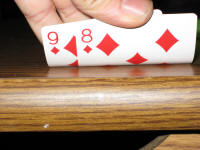Playing Small Suited Connectors in No Limit Hold'em
 Most poker players realize that the biggest pots are won with flushes, straights, and sets. The reason for this is because to make a flush, straight, or set, you had to have a sneaky preflop hand like suited connectors or a small pocket pair, so your opponents have a hard time putting you on the monster hand.
Most poker players realize that the biggest pots are won with flushes, straights, and sets. The reason for this is because to make a flush, straight, or set, you had to have a sneaky preflop hand like suited connectors or a small pocket pair, so your opponents have a hard time putting you on the monster hand.
Although suited connectors win the largest pots, they also can cost you a ton of money if you don't play them correctly. This page is going to teach you the proper way to play suited connectors. We take into account factors like stack size, position, and board texture to present an excellent suited connector strategy:
Playing Suited Connectors Preflop with a Short Stack
Position is an important consideration when you hold suited connectors. When you have a small stack and hold small suited connectors in early position, you should fold your hand. The same goes for middle position. Since you have a short stack, you need to wait for "made preflop hands" - hands like pocket pairs or big cards like AK that can possibly win a showdown without help. You never want to get all-in preflop with small suited connectors.
Your suited connectors are more valuable in late position. If a few players have limped in, you should limp in as well and hope to see a cheap flop. Remember that you should play suited connectors similar to small pocket pairs - get in for cheap, and try to hit a monster flop.
Playing Suited Connectors Preflop with an Average or Large Stack
Players with average or large stacks should play suited connectors the same at a cash table. In early or middle position, you can call small raises or even make small raises yourself with small suited connectors. These sneaky plays will keep your opponents off guard, and should allow you to play the flop beautifully. Since the other players will think you have big cards, you can bet a pretty board like A-K-J and probably steal the pot. And if the board is low, you probably hit it pretty hard, so then you are in great shape too.
In late position you have much more power and are able to steal many pots with suited connectors. If the action folds to you make some 3x raises from the cut off and button with connectors in order to once again disguise your hand. If either of the blinds calls, you will still be in control and hopefully will hit some piece of the flop. Hitting part of the flop against the blinds is much stronger than hitting part of the flop against limpers.
Another play you can consider in late position is the "squeeze". If someone in early position made a small raise, and a few players called, you should make a substantial re-raise to push everyone out of the pot. Since no one really showed much aggression preflop, there are probably a lot of mediocre hands out there that will fold to a re-raise.
Playing Suited Connectors Postflop with a Short Stack
If you followed our preflop advice, you should only see a flop with small suited connectors if you are in late position. Check out the flop and see if you have any sort of straight or flush draws, or if you made a strong hand like trips or two pair. Since the other players have to go first, you can react to their actions:
- If an early position player bets out, and you have nothing, fold.
- If an early position player bets out, and you have a strong draw, use pot odds to decide if you should call.
- If an early position player bets out, and you have a made hand like trips or two pair, raise.
Sometimes when you have a strong draw it can be correct to put in a flop raise, simply to disguise your hand and put pressure on the other player. You may also end up buying yourself a "free card" on the turn. Your raise will scare the other player, and he/she will probably check to you on the turn. Then, if you missed your draw, you can check behind and see the river for free.
Also, if you are extremely short stacked, you should push all-in with a draw or a made hand.
Playing Suited Connectors Postflop with an Average or Big Stack
If you raised in early or mid position preflop, you should play your suited connectors aggressively. If you are first to act, we recommend C-Betting almost any flop (regardless if you hit the flop or not), because you represented strength with your preflop raise. If you called a raise preflop, we recommend playing the hand more cautiously - if you hit something, continue with the hand, and if you missed the flop, throw your hand away.
